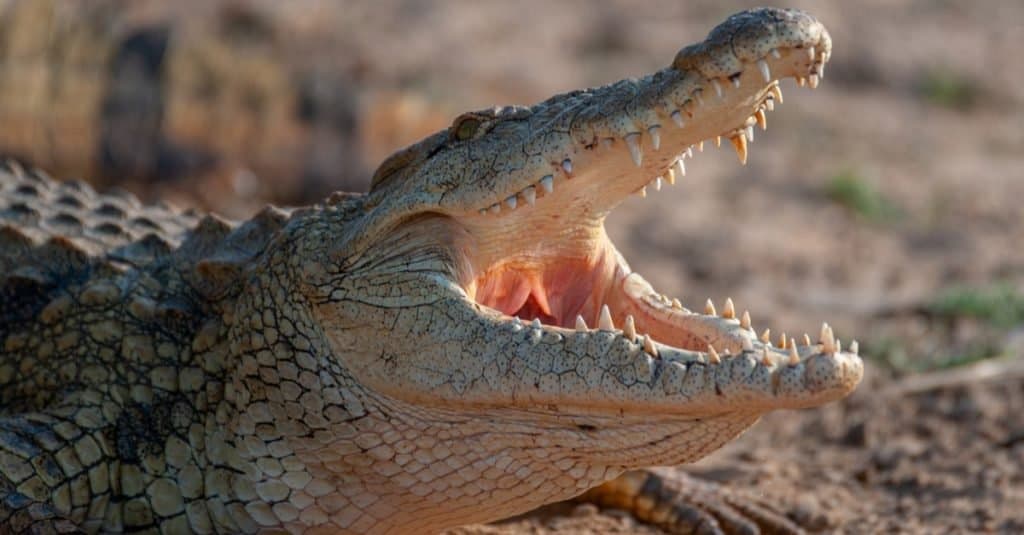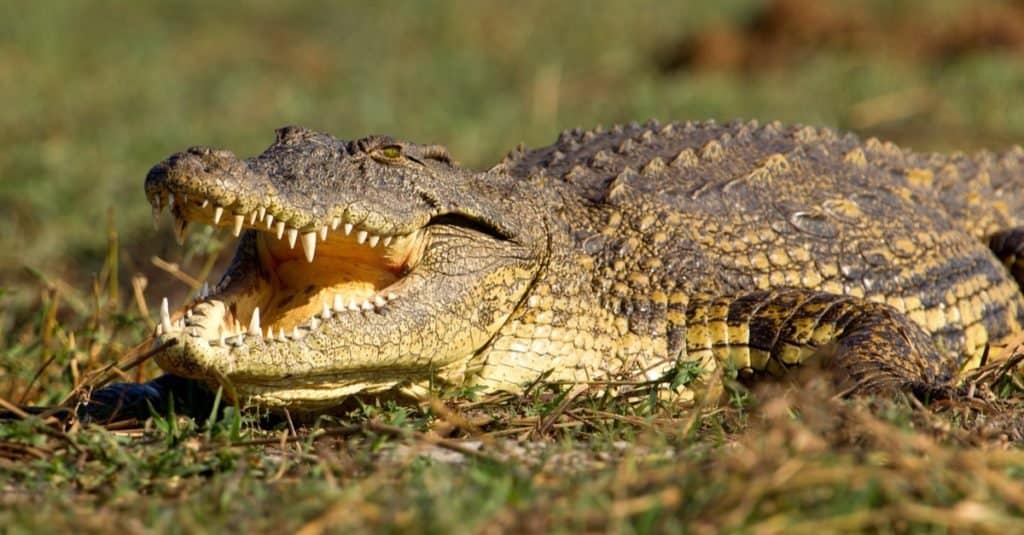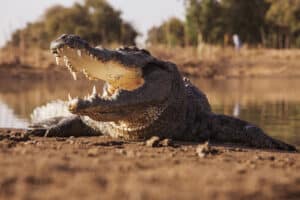Nile crocodiles are one of the biggest species of crocodile around and are the largest freshwater predators in Africa. These large reptiles are opportunistic predators and have incredible strength. Nile crocodiles live in freshwater habitats across Africa and have an average length of 16 feet and an average weight of between 500 and 1,500 pounds.
But just how big can Nile crocodiles get?
We’ll discover the largest Nile crocodile ever recorded, see how they compare against other crocodiles, and learn whether ancient crocodile were even bigger!
Where Do Nile Crocodiles Live and What Do They Eat?
Nile crocodiles are the second largest reptile in the world after the saltwater crocodile. They are a dark olive or brown color and have noticeable spots and stripes across their backs, along with yellowish bellies and flanks. Males are larger than females and can be up to 30% bigger. They are around 20 inches longer at sexual maturity and continue to grow much more than females after they mature.
Nile crocodiles are native to Africa where they are widespread across the continent. However, they are classed as an invasive species in North America. Nile crocodiles are found in a variety of habitats. They are rarely found in true saltwater environments, but are sometimes found in brackish streams. However, they generally prefer swamps, rivers, marshes, and lakes.
These large reptiles have between 64 and 68 teeth and have an incredibly powerful bite. They are ambush predators and have the patience to wait for days or even weeks for exactly the right moment to strike. Nile crocodiles can go for a long time between meals, but when they do eat they can eat up to half of their body weight.
They are apex predators and eat a range of fish, birds, mammals and other reptiles. Nile crocodiles often prey on animals that are drinking at the water’s edge, such as antelope. They usually sink their teeth into them and pull their prey back into the water where they either drown them or kill them by making several sudden thrashes with their head. Nile crocodiles usually take larger prey as they get bigger because they can’t move quick enough to take smaller and faster prey.

Nile crocodiles are fierce apex predators and have an incredibly powerful bite
©Rudi Hulshof/Shutterstock.com
Behavior of Nile Crocodiles
Nile crocodiles are fairly social animals and often share basking spots. They spend much of their day in the shallows or basking in the sun with their mouths open. Despite often appearing motionless, looks can be deceiving and they are always constantly aware of their surroundings and of anyone or anything else near them.
Nile crocodiles have a strict social hierarchy and at the top are the biggest and oldest males. These massive males always get the best basking spots and have access to food before any others do. For the most part, the hierarchy is well respected, but if any crocodile dares to break the rules then the results are often violent and bloody.
Although Nile crocodiles usually only dive underwater for 10 to 15 minutes each time, they can remain underwater for up to 30 minutes if they are threatened. They are active and able swimmers and can even manage short bursts of speed when on land too.
The Largest Nile Crocodile Ever Recorded
The largest Nile crocodile ever officially recorded was a massive 21 feet and 2 inches long. The male crocodile was killed by the Duke of Mecklenburg in Tanzania in 1905 and weighed between 2,300 and 2,400 pounds.
However, there is a legendary Nile crocodile who could easily be as long, if not longer, despite having never been caught or measured. Gustave is a legendary crocodile who roams the banks of the Ruzizi river and Lake Tanganyika in Burundi and is rumored to have killed around 300 people. Although he has never been caught, he was estimated to be around 20 feet and more than 2,000 pounds in 2002 and likely still growing.
Gustave is distinguished by three bullet scars on his right side. He is believed to prey on humans because his incredible bulk means he is unable to hunt the faster animals that Nile crocodiles usually eat. He stalks the river banks and preys on fishermen, children, and anyone who dares to go swimming. Gustave even reportedly killed 17 people in a three-month period.
Gustave became famous for his man-eating tendencies and several films and documentaries were made about him. Numerous attempts were made to catch him – including one involving a 32 foot long custom-built trap and a live goat – but still, Gustave managed to evade them all, proving to be extremely intelligent as well.
The last reported sighting of him was in 2015 when he was seen dragging an antelope into the water, but no one knows if he is still around now. Regardless of whether he is alive or dead, the legend of Gustave is guaranteed to live on for many years to come.

The largest Nile crocodile in the world could well be the legendary man-eater who stalks the shores of Lake Tanganyika in Burundi
©Gaston Piccinetti/Shutterstock.com
How do Nile Crocodiles Compare with other Crocodiles?
There are seventeen recognized species of crocodiles alive in the world today, and the Nile crocodile is the second largest. Saltwater crocodiles are the largest species and reach around 23 feet long. Orinoco crocodiles are slightly smaller than Nile crocodiles. They are generally no more than 16 feet long and have an average weight of 440 to 840 pounds. However, Nile crocodiles are much larger than the dwarf crocodile, which is the smallest crocodile species. Dwarf crocodiles only reach 4.9 feet and up to 175 pounds.
Were Ancient Crocodiles Even Bigger?
Ancient crocodiles were significantly larger than crocodiles today. Sarcosuchus is an extinct crocodile that lived during the Early Cretaceous period in the area that is now South America and Africa. Sarcosuchus grew to an impressive 31 feet and weighed around 9,400 pounds.
Deinosuchus is another large, ancient relative of crocodiles and lived during the late Cretaceous period. Deinosuchus literally translates to “terrible crocodile” and these fearsome beasts measured 35 feet long. They are believed to have been capable of killing large dinosaurs, as well as feeding on a range of fish, sea turtles, and other aquatic prey.
How do Nile Crocodiles Reproduce?

Two Nile crocodiles hatching from eggs
©Catchlight Lens/Shutterstock.com
Nile crocodiles are sexually mature when they are around 14 years old, or 10ft 10ins for males. Males attract females during mating season by making a lot of noise. They do this by blowing water out of their noses and slapping the water with their snouts. During this period males are extremely territorial and often fight – sometimes to the death – with other males. After mating, females wait between one and two months before they lay their eggs.
Females make nests around 20 inches deep on sandy shores, dry river beds, and river banks. On average, they lay between 25 and 80 eggs. Most other crocodiles cover their eggs with rotting leaves and vegetation as it is a good source of heat. However, instead of using leaves, Nile crocodiles cover their nests with sand or soil. This means that they must rely on the heat from the sun to warm the soil enough to provide sufficient heat for incubating the eggs. The temperature of the nest determines whether the young are male or female. Temperatures between 31.7°C and 34.5°C produce males, while anything outside of it produces females.
Females guard the nests for three months, often only leaving to cool off in the water. When it is time for the eggs to hatch they dig open the nest and help the young crocodiles out of the eggs. Females do this by picking up the eggs and rolling them in their mouths to crack the shells. Sometimes, they even carry the newly hatched crocodiles to the water in their mouths. Newly hatched Nile crocodiles are only around 12 inches long when they are born. They remain under their mother’s protection for two years, by which time they are almost 4 feet long.
The photo featured at the top of this post is © Gaston Piccinetti/Shutterstock.com
Thank you for reading! Have some feedback for us? Contact the AZ Animals editorial team.






